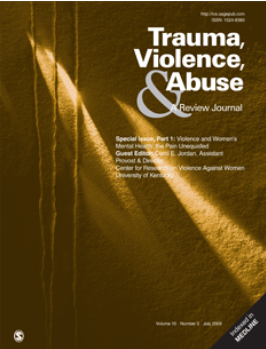The Effect of Gender Role Expectations, Sexism, and Rape Myth Acceptance on the Social Perception of Sexual Violence: A Meta-Analysis.
IF 5.4
1区 社会学
Q1 CRIMINOLOGY & PENOLOGY
引用次数: 0
Abstract
Recent systematic reviews have highlighted the role of certain attitudes in shaping the social perception of sexual violence. This meta-analysis aimed to assess the effect of sexism, gender-role expectations, and rape myth acceptance on the social perception of sexual violence. It also aims to determine whether attitudinal dimensions, participant gender, or the dyadic composition of sexual violence incidents moderate this relationship. A literature search covered published and unpublished manuscripts from January 1, 2010, to December 31, 2023, across PsychArticles, Proquest, and Google Scholar. Manuscripts had to measure at least one attitude and assess participants' perception of material depicting sexual violence between two adults. Data from 40 studies from 10 different countries, involving 12,283 participants, revealed a significant association between attitudes and the social perception of sexual violence (r = .425, p < .001). Meta-regression highlighted the significant contributions of greater gender role expectations, hostile sexism, benevolent sexism, and rape myth acceptance to the social perception of sexual violence incidences. Their combined effect correlated with increased victim blame (r = .558), reduced victim credibility (r = -.492), decreased perception of incident severity (r = -.363) and victim trauma (r = -.390), heightened perceptions of victim pleasure (r = .417), as well as reduced perpetrator blame (r = -.288) and sanction severity (r = -.191). These tendencies were even more pronounced in cases involving same-gender perpetrators and victims. Participant gender was not a significant moderator. These findings underscore the need for prevention efforts to address broader gender biases and power dynamics.性别角色期望、性别歧视和强奸神话接受对性暴力社会认知的影响:一项元分析。
最近的系统审查强调了某些态度在形成社会对性暴力的看法方面的作用。本荟萃分析旨在评估性别歧视、性别角色期望和强奸神话接受度对性暴力社会认知的影响。它还旨在确定态度维度、参与者性别或性暴力事件的二元构成是否会缓和这种关系。文献检索涵盖了2010年1月1日至2023年12月31日在PsychArticles、Proquest和谷歌Scholar上发表和未发表的手稿。手稿必须测量至少一种态度,并评估参与者对描述两个成年人之间性暴力的材料的看法。来自10个不同国家的40项研究的数据,涉及12283名参与者,揭示了态度和性暴力的社会认知之间的显著关联(r =。425, p < 0.001)。元回归强调了更高的性别角色期望、敌意性别歧视、善意性别歧视和强奸神话接受度对性暴力事件的社会认知的重要贡献。它们的综合效应与受害者责备增加(r = - 0.558)、受害者可信度降低(r = - 0.492)、对事件严重性(r = - 0.363)和受害者创伤(r = - 0.390)的感知降低、受害者愉悦感增强(r = .417)以及肇事者责备(r = - 0.288)和制裁严重性(r = - 0.191)的感知降低相关。这些倾向在涉及同性犯罪者和受害者的案件中更为明显。参与者的性别并不是一个显著的调节因素。这些发现强调了预防工作的必要性,以解决更广泛的性别偏见和权力动态。
本文章由计算机程序翻译,如有差异,请以英文原文为准。
求助全文
约1分钟内获得全文
求助全文
来源期刊

Trauma Violence & Abuse
Multiple-
CiteScore
13.60
自引率
7.80%
发文量
131
期刊介绍:
Trauma, Violence, & Abuse is devoted to organizing, synthesizing, and expanding knowledge on all force of trauma, abuse, and violence. This peer-reviewed journal is practitioner oriented and will publish only reviews of research, conceptual or theoretical articles, and law review articles. Trauma, Violence, & Abuse is dedicated to professionals and advanced students in clinical training who work with any form of trauma, abuse, and violence. It is intended to compile knowledge that clearly affects practice, policy, and research.
 求助内容:
求助内容: 应助结果提醒方式:
应助结果提醒方式:


